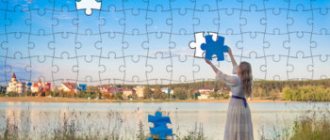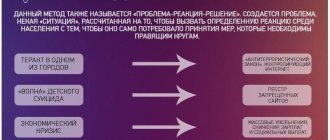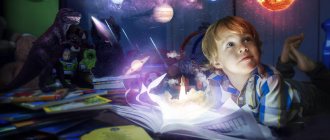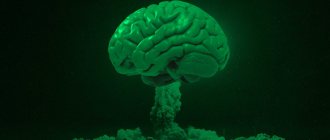Imagination, as the creation of new images, undoubtedly has a high value both for success in any activity and for the development of the personality itself. Usually, when talking about the need to develop imagination, they mean children. This is quite understandable, because it is in preschool and primary school age that the craving for fantasy is especially pronounced, and the development of cognitive processes in general at this age is of fundamental importance.
However, adults also have a need to develop imagination, and in some cases they are very keenly aware of it. And psychologists are convinced that this process can be developed and improved at any age.
Individual characteristics of imagination
Sometimes it seems that some people are born with the ability to creatively imagine, new projects, original ideas, and non-standard solutions are born so quickly and easily. And others are not even able to come up with a fairy tale for their child, not to mention some kind of discovery or creation of a work of art. What's the matter here?
The ability to imagine is inherent in all people from birth; it is associated with the characteristics of higher nervous activity, with the specifics of the exchange of information between nerve cells of the brain. However, this ability manifests itself in different ways. And when developing imagination, one should take into account the individual characteristics of this mental process.
The power of imagination
This is one of the most important and noticeable characteristics of the process of birth of images. Moreover, some people’s fantasies are so vivid that they can compete with real objects. This vividness of imagination is especially characteristic of children.
The point is that the power of imagination is associated with and limited by rational control. The more developed is rational, logical thinking, and, consequently, a rational attitude towards one’s own fantasies and inventions, the weaker the imagination, the more dull, blurry and mundane its images are.
In children, the rational sphere of consciousness is not yet very developed, so their imagination is stronger and more vivid. But children have another problem - a lack of information for creativity and conscious fantasy skills.
True, it cannot be said that rational control only interferes with freedom of imagination. Its limitation is also necessary. If logical, rational thinking is weak, a mental phenomenon such as visionary thinking may arise, when a person is unable to distinguish the products of his imagination from real objects and situations.
- Most often, visionary behavior occurs in children, due to the peculiarities of their thinking. One can recall such an example of visionaryness as the image of an imaginary friend (Carlson, who lives on the roof).
- In adults, visionary vision is much less common, but nevertheless, similar cases have been described in psychology and psychiatry, for example, in exalted believers or in people in a state of passion.
But this is still an exception. And when developing imagination in adults, attention should be paid to developing the ability to consciously restrain rational control and temporarily turn off logic. For this, there are various techniques associated with the activation of non-standard, unconventional thinking.
Ease of birth of images
Imagination is a largely spontaneous process associated with the activity of the subconscious and free associative thinking. Therefore, for some people, new images, plots and ideas are born easily and almost involuntarily, caused by spontaneous associations. Such people will see a fairy-tale monster in a bizarrely curved piece of driftwood, and from an overheard conversation they will create the plot of an entire novel. They constantly notice something surprising, unusual in a completely ordinary world.
Exclaiming: “Look, these cracks in the asphalt resemble the face of a lion!” — they risk being misunderstood and even ridiculed. But they have a very important and useful quality: spontaneous creative thinking and ease of imagination. And others only grunt disdainfully, because they see banal rot in the snags, and the negligence of utility workers in the cracks on the asphalt.
The ease of creating images largely depends on the speed of thinking and the ability to create associations. In general, associative thinking is an important quality for imagination and creativity, and it is worth developing.
Creative thinking
This is one of the three main types of thinking. Along with the visually effective and abstractly logical, it plays an important role in the human psyche. But for the imagination, which operates with images, the level of its development and activity is of fundamental importance.
The imaginative thinking that predominates in preschool age in adults is often suppressed and restrained by abstract-logical thinking. This reduces both the vividness of the images and the power of imagination. But as you know, the right hemisphere of the brain is responsible for operations with images, while the left hemisphere is responsible for operations with concepts, signs and logical thinking. And there are people who are called right-hemisphere people because of the increased activity of this hemisphere of the brain. Such individuals have no problems with imaginative thinking and imagination. But left-hemisphere people should take care of the development of such an important cognitive process.
Emotional intensity of images
Imagination and emotion are closely related, and people with vivid, strong emotions tend to have more productive imaginations. Therefore, many famous artists, writers, and actors were distinguished by increased exaltation.
- Emotions, on the one hand, make the products of imagination alive, “realistic”.
- On the other hand, connection with emotions guarantees a person’s pleasure from the results of his creativity.
Individual characteristics of imagination are largely related to the innate characteristics of our psyche. But despite this, they can be developed. The main thing is to take into account the specifics of human cognitive processes and emotions.
Method of resolving contradictions
The goal of the contradiction resolution method is to get rid of the contradictory properties of an object or system. Contradictions can be resolved in time, space, structure, influences, relationships. These principles were first presented by G.S. Altshuller, the founder of the theory of inventive problem solving (TRIZ). For a comprehensive and rational solution to a certain problem, it is most often necessary to identify contradictions in several ways without the use of additional means.
The time conflict resolution method has the following formula: Udder interval T1 has a variable resource that has the property "A", while time interval T2 has a variable resource with the property "not A".
Have questions about this topic? Ask a question to the teacher and get an answer in 15 minutes! Ask a Question
The method for resolving contradictions in space has the formula: place M has a variable resource with property A, and place M2 has a variable resource “not A”.
The method for resolving contradictions in the structure has the formula: a certain mutable resource has several parts, one part or parts is A, the other part(s) are “not A”.
The method for resolving contradictions in impacts has the formula: with one type of impact (impact 1) on a certain variable resource, this resource begins to have property A, and with another type of impact (impact 2), the variable resource begins to possess property “not A”.
The method for resolving contradictions in relationships has the following general formulation: in relation to standard 1, the variable resource will have the property “A”, and in relation to standard 2, the variable resource will have the property “not A”.
Mastering the technique of imagination
No matter how attractive the easy and spontaneous birth of new images and ideas may seem, any cognitive process is more effective when it is subordinated to our consciousness, goals and objectives of activity, that is, it is voluntary.
Techniques of creative imagination
Voluntary imagination requires proper organization, and one of the most important areas for the development of creative imagination is learning the technique of creating new images.
People unknowingly used such methods or techniques back in ancient times, creating fantastic images and plots of myths and fairy tales. And nowadays writers, artists, scientists use these techniques to organize the process of their creativity.
- Hyperbole and litotes (exaggeration and understatement). This is one of the simplest techniques for transforming images of reality. This method can be used both in relation to the object as a whole (Thumbelina, Thumb Thumb, giant, etc.) and in relation to individual elements of the object (Dwarf Nose, Karabas Barabas with a long beard, etc.).
- Agglutination (gluing). This is an ancient and quite effective technique that uses the ability of our thinking to synthesize the details of images in memory. Agglutination can be quite simple, as, for example, in the images of a centaur (half-man, half-horse), naga (half-man, half-snake), sphinx (lion with a human head). But the parts being connected can be previously modified, distorted, and then the technique of agglutination allows you to create completely fantastic characters or paintings. Agglutination is often used in fiction, including realistic literature, when a writer creates an image of a hero using the character traits of several real people. This technique is also used in design; many modern mechanisms, instruments, mechanisms, and gadgets combine elements of various devices, for example a mobile phone.
- Accentuation is a change in the proportions of an image or its characteristics by highlighting, “protruding” individual features. This technique is often used in caricatures, cartoons, jokes or feuilletons. One example of accentuation is the image of the absent-minded from S. Marshak’s poem. In this poem, a generally ordinary character trait is brought to the point of absurdity, thereby creating a satirical effect.
- Typification is the process of creating typical images, that is, combining the most typical features of a group of objects. This technique is often used in fine arts and literature to create images of typical representatives of society. For example, the types of landowners in “Dead Souls” by N.V. Gogol. Typification is one of the most complex and “intelligent” techniques of imagination, since it involves not only a careful analysis of objects, but also the construction of a new holistic image based on disparate features.
- Personification is giving images of inanimate objects the characteristic features of living beings. This technique is often found in fairy tales and fantasy literature, for example, the stove and apple tree from the fairy tale “Geese and Swans”, dishes from K. Chukovsky’s poem “Fedorino’s Grief”.
- Addition is the endowment of objects with new properties and functions. This technique is used not only in fairy tales (magic carpet, rejuvenating apples), but also in design, in the development of goods with new properties. For example, a vacuum cleaner brush, a lighter with a flashlight, a pillow with a scent.
In the creative process, these techniques are often combined, mixed, and complementary, which makes it possible to obtain images that are completely unique in their characteristics or to find original solutions to problems.
Mastering the techniques of creative imagination is not only useful, but also interesting. It can be organized in the form of exciting games that not only children, but also adults enjoy playing.
Examples of exercises for mastering imagination techniques
Exercise “Image of an inhabitant of another planet” (agglutination)
Using the agglutination technique, you need to figure out what an intelligent creature from another planet with conditions different from those on Earth might look like. For example, the inhabitants of the planet “Ocean”, or a planet whose atmosphere consists of burning gases, or a planet so densely overgrown with impenetrable bushes that it is difficult to move in it, etc.
You can try to draw imaginary images. Drawing is very useful, it stimulates imaginative thinking and makes the products of your imagination tangible.
Exercise “Hero of Our Time” (typing)
Based on identifying the most characteristic features and characteristics, create typical images of people in our society: a regular on social networks (VKontakte, Odnoklassniki), a modern designer, a feminist, an anime fan, etc.
Exercise “Useful things” (addendum)
Using the adjective technique, come up with and describe several ordinary things with new useful properties. For example, you can take things such as a comb, a tablespoon, slippers, or a rug near the door for improvement.
Exercise “What would happen if…” (hyperbole and litotes)
You need to think, model and describe the situation that would arise if you suddenly increased in size to the size of a five-story building. What would you feel is an advantage and what would you feel is a disadvantage? How would you behave? What would you do? How would you begin to build relationships with others? You can organize your thoughts into a coherent story.
Then the reverse process occurs, but you shrink and become the size of a mouse. How would this affect your behavior? What do you see as the advantages of such growth, and what are the disadvantages?
This exercise is very popular among children, but for adults it is also useful for the development of imagination, and for the formation of unconventional thinking and the ability to go beyond the banal routine and standard logic.
Despite the fact that the process of imagination development in adults and children has much in common, it is still worth paying attention to the differences and features.
Morphological method
The morphological method can have two main goals: firstly, it is needed to bring into the system possible options for solving a problem, and secondly, it can be used for the purpose of fantasy.
First you need to analyze the object or system. Then it is necessary to isolate the main properties that are important for solving a certain problem or achieving a goal. Each property must be scaled. You should then explore all possible values on these scales.
Note 1
This method is very effective for finding non-standard solutions that cannot quickly arise in the imagination. A disadvantage of this method is that many false options appear during the selection process.
Features of imagination development in childhood
Psychologists call preschool age sensitive, that is, the most sensitive for the development of imagination. This is due to the mental characteristics of a preschooler:
- predominantly figurative nature of thinking;
- openness to everything new and bright;
- liveliness and brightness of images;
- freedom from stereotypes and templates that have not yet formed;
- the opportunity to conduct developmental activities in a playful form, preferable for the development of imagination.
But there are also problems that should be taken into account when organizing classes with preschoolers. One of the most serious is the lack of figurative, sensory information in memory, material for the work of the imagination. Therefore, it is necessary to start with the development of perception, including creative perception, that is, the ability to be observant, to notice the unusual in ordinary things, to be able not just to look, but also to see, not just to listen, but to hear.
Exercises to search for the unusual in a familiar environment are very useful for developing this type of perception. Exercises in drawing geometric shapes, abstract lines and zigzags into recognizable images also contribute well to the development of creative vision and imagination.
The second problem is mental instability. Children of this age still have poor control of voluntary attention, are often distracted and quickly get tired if they have to engage in serious mental work. And in no case should children be forced; all developmental activities should be done willingly and bring pleasure.
Therefore, adults need to actively participate in the exercises and captivate children by their example. It’s also good to develop your imagination while walking or on long trips.











